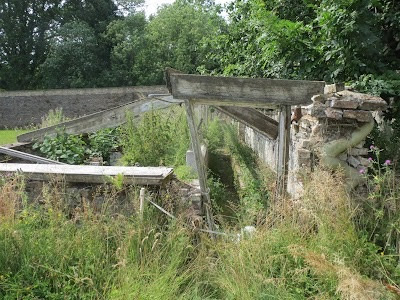I first visited it in about 1977, when the estate manager took us on a guided tour of the Castle - I'd written to Lord Erne in advance, requesting a visit.
The Walled Garden lies deep within the grounds of Crom (pronounced Crum).
You cross the White Bridge and walk several hundred yards until it appears, the former head gardener's lodge being opposite it.
Its old, red-brick walls are in good condition, the National Trust having re-built at least one side some years ago.
It extends to roughly three acres in size; and has become overgrown since its demise after the second world war.
It is to be hoped that the National Trust restores this special place as and when funds become available.
 |
| Ruinous glass-houses (Timothy Ferres, 2013) |
Many fruits and vegetables were grown here for the big house.
Exotic fruits, which are nowadays taken for granted, were a rarity then and only the wealthiest families could afford to cultivate them.
In fact many people may never have seen a pineapple or a peach or known they existed.
On one side of the Walled Garden there were raspberries; and strawberries on another.
Heated glasshouses contained peaches, nectarines, pineapples, grapes and tomatoes; not to omit lettuce, marrows, cucumbers and orchards with apples, plums, pears and greengages.
There were also beehives, sweet-pea, daffodils, dahlias and magnolias.
 |
| Location of former palm-house (Timothy Ferres, 2013) |
In the middle of the garden there was a large palm-house surrounded by a lily pond, now sadly gone, 25-30 feet high, where the weather-reading was taken every morning.
The whole garden swarmed with butterflies, bees and other wild insects; birds flitted in and out to help themselves to Nature's goodness.
It must have been heavenly.
Of course the main purpose of the walled garden was to maintain an abundant supply of produce, including flowers, for the Castle: a barrow was wheeled manually up to the Castle with fruit, vegetables and flowers twice daily.
When the family were staying at their London home, the freshly-picked produce was loaded on to the train at Newtownbutler station and taken to Belfast or Dublin; then put on a ferry for its long journey to the metropolis, where it would have been delivered to the Ernes' house the next day; and that was in Victorian times!
I have been in the Walled Garden and my imagination always escapes to those halcyon days, dreaming of what it must have been like.
My fervent hope is that the enchanting walled garden of Crom is resurrected back to life again some day.
This piece was first published in August, 2008. It is thought that the intention is to utilize part of the Walled Garden as community allotments.

Stayed there most of last week and had the most glorious weather ever
ReplyDeleteDid you see the walled garden? Is it still a wilderness? I'd dearly love it to be restored.
ReplyDeleteTim,do you know of all the times,which are many, i never have crossed the white bridge.:(
ReplyDeleteI recall it needed restoration when the NT took over about 1987-88.
ReplyDeleteWhat are your thoughts on the Bangor Walled Garden... it took me 8 years to get the Council to agree to save it. Do you think it has been planted and developed the way that it should be?
ReplyDeleteAnon, I haven't revisited tthe Walled Garden of Bangor Castle for a few years. I've written about it on the blog. When I last visited it I found it all impressive.
ReplyDeleteI'm afraid I couldnt say how true the layout is now, in comparison to the original.
"it has been utterly overgrown since its demise after the second world war"
ReplyDeleteNot quite so. I actually worked there in the Summer of 1970 when it was substantially active under the guidance of Jemmie Moran and his son Cecil. I specifically recall delicious apples being readied for Nettownbutler or maybe Clones Show.
Michael, many thanks for letting me know. I'll amend that part. Tim.
ReplyDelete